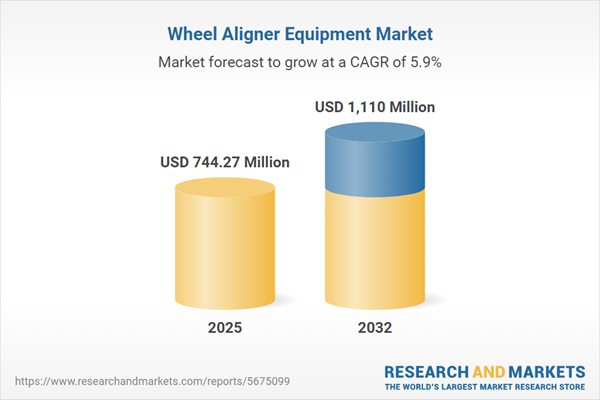Speak directly to the analyst to clarify any post sales queries you may have.
Senior decision-makers in the automotive sector are navigating a wheel aligner equipment market defined by technological advancements, shifting compliance standards, and an increasing demand for precise service delivery. Succeeding in this landscape requires adaptive strategies, operational efficiency, and proactive investment in regulatory and technology readiness.
Market Snapshot: Wheel Aligner Equipment Market Size & Growth
The global wheel aligner equipment market is projected to grow from USD 703.67 million in 2024 to USD 744.27 million by 2025, reaching a total value of USD 1.11 billion by 2032. This represents a steady compound annual growth rate of 5.86%. The expanding market is shaped by the integration of advanced alignment technologies, heightened regulatory attention to automotive safety, and rising performance expectations across vehicle classes. Additionally, the growing adoption of electric vehicles (EVs) is driving organizational investment in innovative alignment solutions to meet new operational and compliance demands.
Scope & Segmentation: Wheel Aligner Equipment Market
- Vehicle Types: Heavy commercial vehicles, light commercial vehicles, and passenger cars each necessitate tailored alignment technology, reflecting diverse structural designs and drivetrain needs.
- Operation Modes: Fully automatic, semi-automatic, and manual systems provide choice, helping workshops match their workflow requirements and technician expertise.
- Equipment Types: 2D and 3D stationary aligners, portable units, and mobile solutions allow workshops to optimize space utilization or respond to on-site service demands.
- End Users: Aftermarket centers, tire retailers, independent garages, dealerships, and general service workshops all benefit from equipment solutions shaped for distinct operational and customer requirements.
- Distribution Channels: Direct sales, distributors, specialist solution providers, and online platforms enable businesses to manage procurement and supplier relationships at scale.
- Service Types: Robust lifecycle management includes periodic calibration, planned maintenance, technical troubleshooting, and structured technician training, ensuring reliable operation and service quality.
- Regions: The Americas, Europe, Middle East & Africa, and Asia-Pacific each present unique adoption rates and regulatory standards, requiring adaptable technologies and region-specific go-to-market strategies to suit varying levels of market maturity.
Key Takeaways for Senior Decision-Makers
- Digital imaging and advanced sensor integration have significantly enhanced measurement accuracy and throughput, improving workflow for enterprises of all sizes.
- The accelerating shift toward electric vehicles prompts a greater need for technician upskilling and precise calibration routines to maintain compliance and reduce risk of downtime.
- Subscription-based service offerings and remote diagnostics are enabling more recurring revenue opportunities and strengthening business-client relationships in the aftermarket environment.
- Collaboration between manufacturers, technology companies, and original equipment providers is leading to the adoption of modular systems designed for future upgrades and evolving standards.
- Emphasizing ongoing professional development and routine equipment assessments aids consistent service quality in rapidly changing regulatory contexts.
Tariff Impact: United States Policies and Market Implications
Forthcoming U.S. import tariffs on wheel aligner components, set to take effect in 2025, are leading organizations to revisit their cost models and supply chain strategies. Many players are opting for nearshoring and broader supplier diversification to ensure stability in procurement and greater resilience against fluctuating costs.
Methodology & Data Sources
The insights in this report are grounded in thorough secondary research, direct interviews with senior automotive executives, and operational perspectives from workshop technicians. Findings are verified by a proprietary system, ensuring decision-makers receive reliable and actionable information.
Why This Report Matters: Strategic Value for Wheel Aligner Equipment Market Leaders
- Delivers clear, data-driven guidance to optimize procurement and leverage the most relevant technology and regulatory trends.
- Empowers leadership to strengthen supply networks and adopt solutions that align with regional demands and compliance requirements.
- Supports well-informed decisions, helping organizations achieve greater efficiency, operational continuity, and sustained growth in a changing market.
Conclusion
This report equips senior automotive leaders with the insights needed to adapt quickly, invest wisely in technology, and maintain compliance across evolving market and regulatory conditions. It enables strategic planning for continued progress in the dynamic wheel aligner equipment market.
Additional Product Information:
- Purchase of this report includes 1 year online access with quarterly updates.
- This report can be updated on request. Please contact our Customer Experience team using the Ask a Question widget on our website.
Table of Contents
3. Executive Summary
4. Market Overview
7. Cumulative Impact of Artificial Intelligence 2025
Companies Mentioned
The companies profiled in this Wheel Aligner Equipment market report include:- Hunter Engineering Company
- Snap-on Incorporated
- Beissbarth GmbH
- John Bean Technologies Corporation
- Ravaglioli S.p.A.
- Hofmann Megaplan GmbH
- Launch Tech Co., Ltd.
- Corghi S.p.A.
- Coats Group plc
- Celette SA
Table Information
| Report Attribute | Details |
|---|---|
| No. of Pages | 182 |
| Published | October 2025 |
| Forecast Period | 2025 - 2032 |
| Estimated Market Value ( USD | $ 744.27 Million |
| Forecasted Market Value ( USD | $ 1110 Million |
| Compound Annual Growth Rate | 5.8% |
| Regions Covered | Global |
| No. of Companies Mentioned | 11 |









